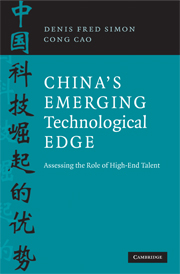Book contents
- Frontmatter
- Contents
- List of Figures and tables
- Acknowledgements
- Abbreviations
- Introduction
- 1 Human resources, technological innovation, and economic growth
- 2 China's talent challenge
- 3 Human resources in science and technology, and their structure and characteristics in China
- 4 Higher education and scientists and engineers in the pipeline
- 5 Utilization of scientists and engineers in China
- 6 “Brain drain,” “brain gain,” and “brain circulation”
- 7 Supply and demand of science and technology talent in China: key drivers
- 8 China's talent in key emerging technologies
- 9 Whither China's talent pool?
- Appendix: Understanding Chinese science and technology human resources statistics
- References
- Index
6 - “Brain drain,” “brain gain,” and “brain circulation”
Published online by Cambridge University Press: 25 January 2011
- Frontmatter
- Contents
- List of Figures and tables
- Acknowledgements
- Abbreviations
- Introduction
- 1 Human resources, technological innovation, and economic growth
- 2 China's talent challenge
- 3 Human resources in science and technology, and their structure and characteristics in China
- 4 Higher education and scientists and engineers in the pipeline
- 5 Utilization of scientists and engineers in China
- 6 “Brain drain,” “brain gain,” and “brain circulation”
- 7 Supply and demand of science and technology talent in China: key drivers
- 8 China's talent in key emerging technologies
- 9 Whither China's talent pool?
- Appendix: Understanding Chinese science and technology human resources statistics
- References
- Index
Summary
This chapter examines China's human resources in science and technology (HRST) from the perspective of flow – the outflow of Chinese overseas as students and scholars (liuxuesheng). Studying overseas (liuxue) is not a new phenomenon in China, but it is the reform and open-door policy initiated in the late 1970s that has offered Chinese more education and training opportunities on a global scale. The expansion of China's science and technology (S&T) and educational exchanges with the outside world has opened up a broad array of new, substantial opportunities for study abroad through both government sponsorship and private channels. The significance of overseas study is reflected not only in the overall number of liuxuesheng, but in the critical role of those who have returned to China after finishing their studies. The returnees (haigui, literally meaning “sea turtles”), especially those who have returned in recent years to take advantage of a booming economy and the government's favorable policies toward them, are strategically important to China's rise as a global economic and technological power, and even to China's political evolution to some extent as well (Li, 2004, 2005a). China has also experienced a “brain circulation,” in which many ethnic Chinese professionals and scientists residing overseas help their native country by acting as information conduits and collaborative partners in new business ventures (Saxenian, 2002, 2006).
- Type
- Chapter
- Information
- China's Emerging Technological EdgeAssessing the Role of High-End Talent, pp. 212 - 253Publisher: Cambridge University PressPrint publication year: 2009



